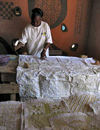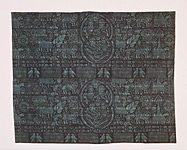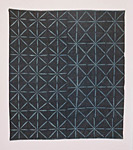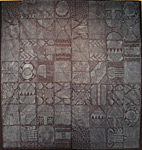Joyful Blues: Yoruba Indigo-Dyed Cloths
Patterned with a fascinating repertoire of resist techniques, Yoruba indigo-dyed cloths testify to the vitality and adaptability of an ancient west African textile tradition. The earliest known example, a tie-dyed cap from Mali dating to the 11th-12th century, bears a “big moons and little moons” design that is still used today. Over the years, this simple tied-resist has been expanded to include folding, pleating, binding, knotting and sewing, developing a rich vocabulary of patterns and variations.
In the early 20th century, competition from imported printed fabrics inspired Yoruba textile specialists—typically women—to devise new techniques. Hand-painted starch resists were used to create finely detailed figurative or geometric designs. Hand-painting was extremely labor-intensive, and dyers soon began using stencils to achieve similar, if cruder, effects. More recently, wax resists have been used as well.
Indigo has a special place in Yoruba culture, where color has sacred associations. White, for example, connotes cool calmness, wisdom, and age, while blue evokes balanced brightness. Indigo-dyed adire (“hand-dyed cloth” in Yoruba) are made in two sizes. The first is 2 ½ yards long and half the standard width for a woman’s wrapper. Two of these lengths are tied together before dyeing, creating identical fabrics which are later sewn together. Women wear the smaller adire as a shawl over one shoulder. In recent years men have also worn shirts made from indigo adire as an expression of cultural pride.
The adire in this exhibition were collected by Henry J. Drewal, Evjue-Bascom Professor of African and African Diaspora Arts at the University of Wisconsin-Madison, in the Oje Market in Ibadan, Nigeria between 1975 and 1986. Despite the creativity, skill, and time required to produce them, adire have never commanded high prices in Nigerian markets. Today older adire are rarely offered for sale, and very few artists are maintaining the art form and attempting to adapt it to contemporary fashions. The exhibition includes several excellent examples of recent adire garments and wall hangings.
Contents: 23 adire cloths, 6 contemporary adire textiles and garments, 5 wall text panels, 3 photo panels, a film showing the techniques used by adire cloth specialists, and print-ready brochures. (A larger version of the show is available upon request.)
Size: 200-250 running feet
Fee: $8,000 plus shipping
Tour begins Fall 2009
For booking information, contact Henry Drewal
Click here for exhibition checklist and photos
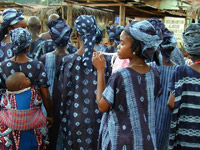
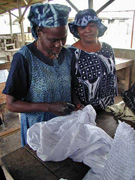
balls.jpg)
